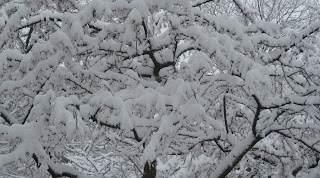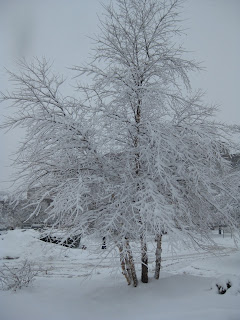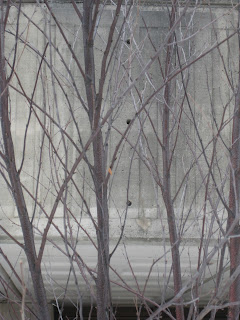Today at Peebles Island, there were two trees that I tried to identify. As I found when I tried to identify trees last summer, mostly I can't figure out what trees are when I try to identify them. But somehow in time, I got to know what many of the trees I see were, so maybe in time, I will come to realize what these are too. The way it works is I study the trees, I study the books, and at first there is no connection between books and reality, but then all of a sudden, I find I know the name of a tree I've been seeing for a while. I think it's good that way. I think it would feel like cheating if someone just told me what they all were. That would take the fun out of it.
The first had smooth gray bark on the trunk, but the twigs were more rust-colored. The buds were opposite and were sort of a yellow or tan color, maybe with a reddish/brownish tint. The branches split and pointed upward.
My observation of the second tree was cut short because when two people and a dog came by, I moved on. However, I noticed several of this kind of tree along the path, including one next to the above tree. This tree was dark gray with lenticels. The book I'm using, A Guide to Nature in Winter indicates that if it has lenticels and catkins it's birch, if no catkins, it's cherry. I find the trees I see in reality often aren't in the books, but this tree had no catkins, and when I look at cherry twigs on the internet, it seems plausible that this could be cherry.
Sunday, February 27, 2011
Saturday, February 26, 2011
More snow
The trees are so pretty with the snow on them.
The Japanese maples seem to look especially nice with snow on them. There is something wispy about them.
The fruit trees at work that Bob said might be cherry or crabapple:
Locust:
Sycamore:
Birches:
Assorted and unknown:
Oak:
Red maples:
Cottonwood:
A tree on the way home from work. I am not sure what kind it was, but I know there are ash in that area, so probably it was ash:
The boxelder in my yard:
The Japanese maples seem to look especially nice with snow on them. There is something wispy about them.
The fruit trees at work that Bob said might be cherry or crabapple:
Locust:
Sycamore:
Birches:
Assorted and unknown:
Oak:
Red maples:
Cottonwood:
A tree on the way home from work. I am not sure what kind it was, but I know there are ash in that area, so probably it was ash:
The boxelder in my yard:
Thursday, February 24, 2011
Orange tree
I saw an orange tree! And I don't mean a tree that bears the fruit we call an orange. I mean a tree that is actually orange in color. I looked on the internet to see what it might be, and my best guess is coral bark maple. I didn't get close enough to the tree to see if it had opposite buds, because there was snow in the way.
Monday, February 21, 2011
Trees do not always reach upward
When I went to Peebles Island yesterday, the theme which emerged was that trees do not always point up. Some had broken branches pointing downward. I am guessing the reason there were so many broken branches is because of the heavy snow we've had this winter.
A big branch had fallen to the ground on this big old oak.
Basically the same view, but angling toward the sun created a more silhouetted look:
A closer view of the fallen branch, as it angled downward from trunk to ground:
Though the part of the tree that was standing was bare, the part that was on the ground had an abundance of leaves:
Another tree with a broken branch:
It was not only broken branches which caused trees to point other than upwards. Some were leaning sidways:
Some seemed to curve downward:
This one was both leaning and broken:
Sometimes it was not the trees themselves that seem to go downward, but the vines that were twined around them:
The large sycamore did not point downward at all, but was reaching for the sky:
A big branch had fallen to the ground on this big old oak.
Basically the same view, but angling toward the sun created a more silhouetted look:
A closer view of the fallen branch, as it angled downward from trunk to ground:
Though the part of the tree that was standing was bare, the part that was on the ground had an abundance of leaves:
Another tree with a broken branch:
It was not only broken branches which caused trees to point other than upwards. Some were leaning sidways:
Some seemed to curve downward:
This one was both leaning and broken:
Sometimes it was not the trees themselves that seem to go downward, but the vines that were twined around them:
The large sycamore did not point downward at all, but was reaching for the sky:
Wednesday, February 9, 2011
Winter twig photos
I found some winter twig photos at http://spicebush.blogspot.com/2011/01/quiz-3-answers.html.
Trees by the library
Today on lunch hour, I observed two types of trees by the library. All were small. Sometimes one doesn't know whether trees are small because they are young, or because it is their nature -- maybe they are shrubs, or a type of tree that just doesn't get much bigger.
The trees along the side of the library had peeling white bark, so I figured they were birch. Well, it wasn't a snow-white color, like the trees I noticed the other day. It was more red or yellow or rust. The trees were the same shape as the birches I observed the other day -- one sapling-size twig, and lots of twig-size branches. While much of the trunk bark was whitish, the branches and some of the trunk were darker, in kind of a red-gray way.
Some were all dark, without the white:
At first I had thought the outer bark was whitish, and the darker color was where all the white had peeled away. But when I looked closer, it seemed the darker color was the outer bark, and the white was inside, where it had peeled back.
The two trees behind the library were short and stubby. Shorter than the birches, but with wider, fuller branching. I thought they might be beeches I had heard that the other trees besides oaks that have brown leaves in winter are beeches. The twigs forked at the end, with end buds at the ends of each fork. The buds were puffy, then pointed, like in Russian architecture.
I looked for side buds but did not see any. The bark was mostly gray, but on one of the trees, there was a patch on the trunk that had peeled off to reveal reddish bark below.
When I got home and checked my book, naturally what I saw did not match anything in the book. There was a bush called hobblebush with the twigs that fork at the end, but the hobblebush buds were a different shape, and I read that hobblebush branches reach out more horizontally. However this picture that I took of the same tree or bush looks a little more like the pictures of hobblebush that I found on the internet:
The trees along the side of the library had peeling white bark, so I figured they were birch. Well, it wasn't a snow-white color, like the trees I noticed the other day. It was more red or yellow or rust. The trees were the same shape as the birches I observed the other day -- one sapling-size twig, and lots of twig-size branches. While much of the trunk bark was whitish, the branches and some of the trunk were darker, in kind of a red-gray way.
Some were all dark, without the white:
At first I had thought the outer bark was whitish, and the darker color was where all the white had peeled away. But when I looked closer, it seemed the darker color was the outer bark, and the white was inside, where it had peeled back.
The two trees behind the library were short and stubby. Shorter than the birches, but with wider, fuller branching. I thought they might be beeches I had heard that the other trees besides oaks that have brown leaves in winter are beeches. The twigs forked at the end, with end buds at the ends of each fork. The buds were puffy, then pointed, like in Russian architecture.
I looked for side buds but did not see any. The bark was mostly gray, but on one of the trees, there was a patch on the trunk that had peeled off to reveal reddish bark below.
When I got home and checked my book, naturally what I saw did not match anything in the book. There was a bush called hobblebush with the twigs that fork at the end, but the hobblebush buds were a different shape, and I read that hobblebush branches reach out more horizontally. However this picture that I took of the same tree or bush looks a little more like the pictures of hobblebush that I found on the internet:
Subscribe to:
Posts (Atom)



















































